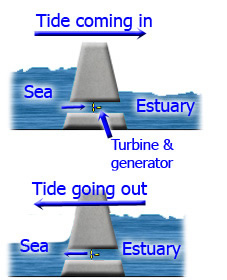 |
| Fig 1: Tidal Stream Generator schematic from Flickr |
In Sep 2013, BBC reported that Scottish Energy Minister Fergus Ewing consented to the development of the largest tidal turbine array in Europe as a step towards generating renewable energy to combat climate change. This represents a major step towards tidal energy generation that may have the potential to meet 20% of the UK's electricity demand.
There are various methods of harnessing tidal power, such as the tidal stream generator (TSG) in Fig 1 and the tidal barrage in Fig 2. These have been undertaken by various countries such as China, France, Korea, the UK, and the USA (Rourke et al, 2010). Tidal barrages can be constructed in an estuary or a bay in high tide areas (Grabbe et al, 2009). In comparison, TSGs would have lesser impact on the environment than tidal barrages due to the avoidance of dam construction, and tidal barrages have a higher cost of construction compared to TSGs.
 |
| Fig 2: Tidal Barrage Schematic by Andy Darvill |
Tidal energy has the key advantage of having greater predictability on its availability compared to other renewable energy sources such as solar and wind, however it still suffers from the problem of being intermittent (Griffin and Hemer, 2010). In comparison to wind turbines, tidal current turbines generate a much larger thrust due to the density of seawater, and thus requires use of a stronger material which results in greater capital costs. (Rourke et al, 2010).
Meanwhile, Ward et al (2012) suggests that future sea-level rise can have significant impacts on the tidal dynamics of the area, which is further enhanced when the effects from tidal power plants are incorporated. Impacts to tidal amplitudes, currents and associated tidal dissipation and bed shear stresses may be observed.
In terms of CO2 emissions savings, Denny (2009) conducted a study based on Ireland which found that with 560 MW of installed tidal generation, CO2 emissions can be reduced by 501 kiloton, which translates to 2% of the total Irish system's CO2 emissions. Grabbe et al, (2009) also cited that life cycle assessment for a marine current turbine compares well with offshore wind turbines in the areas of carbon intensity and energy payback period.
From the angle of public perception, Devine-Wright (2011) conducted a survey which found general public support for tidal energy in Ireland. He suggests that by capturing the symbolic meanings associated with places proposed for development, the public may be better able to accept project proposals for renewal energy.
In conclusion, tidal power plants have the advantage of providing a predictable, but intermittent electricity supply, and there are challenges in terms of cost. More studies would also be needed to determine the marine environment impact arising from tidal power plant construction and operation.
Fergus Ewing says that up to 400MW could be generated from the Pentland Firth site. However, compared to UK demand of 36GW, it's peanuts. Assuming development of the Severn Estuary, and all other possible tidal sites, I've seen estimates of 5-10% UK electricity generation (assuming no demand growth, and neglecting energy demand for meat, liquid fuels, heating etc.) - far below your 20% projection.
ReplyDeleteEven if 20% were doable, sites like the Severn Estuary are globally rare. I'm not convinced that tidal will contribute much to electricity supply, compared to e.g. desert solar or nuclear fission/fusion.
Thank you for the comment and views. For the 20% estimate by the Carbon Trust, the document below on "Accelerating Marine Energy" located at this link (pg 3) could help provide some information on how the estimate was derived. Thanks!
Deletehttp://www.carbontrust.com/media/5675/ctc797.pdf
Hi Joon,
ReplyDeleteThanks for the interesting post on tidal power. You mention briefly that further studies are required to assess the environmental impacts of this method of energy generation. I was wondering if there is any information out there on possible impacts on aquatic ecosystems?
Cheers,
Katherine